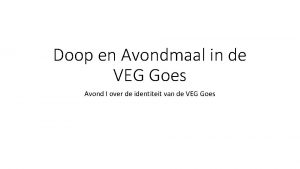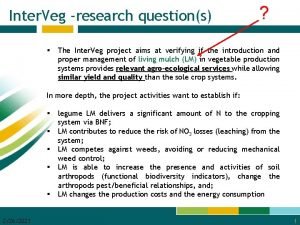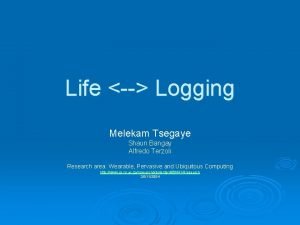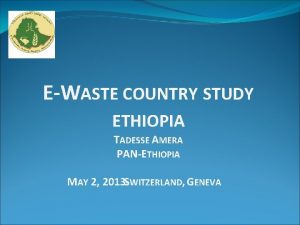An Introduction to Veg Out Dr Tsegaye Tadesse












- Slides: 12

An Introduction to Veg. Out Dr. Tsegaye Tadesse National Drought Mitigation Center (NDMC) University of Nebraska-Lincoln Bismarck, ND October 22, 2007

What is Veg. Out? A new experimental tool to provide future outlooks of general vegetation conditions (seasonal greenness) based on an analysis of information that includes: 1. climate-based drought index (PDSI & SPI) 2. satellite-based vegetation information (seasonal greenness from NDVI) 3. biophysical characteristics (land cover type, ecoregion type, irrigation status, and soil available water capacity) 4. oceanic indicators (~10 indices)

Climate data Satellite data Data integration algorithms SPI generation for Scenario based Prediction (Stochastic) Oceanic data Modeling using regression tree Veg. Out Maps Current SPI, SSG, & oceanic indices Generation Biophysical data

Veg. Out Products: Series of maps depicting future outlooks of general vegetation conditions at a 1 -km 2 spatial resolution that are updated every 2 weeks. 1) 2 -week Vegetation Outlook map 2) 4 -week Vegetation Outlook map 3) 6 -week Vegetation Outlook map * Release of initial experimental Veg. Out products during the 2 nd half of 2007.

Types of Vegetation Outlooks 1) Historical-pattern (time-series relationships) – outlooks based on the diagnostic historical records 2) EX - if the current climate, vegetation, and oceanic conditions are similar to previous drought years (e. g. , 1989, 2002, etc), then the following 2 -, 4 -, and 6 -week would have similar drought patterns as those drought years. 3) 2) Scenarios - outlooks based on implementation of the model using percentage(s) of precipitation expected over the specific outlook period. EX. – 50% of normal precipitation over the next 2 week period used to calculate the 2 -week Veg. Out map • Multiple scenarios using different % - 0%, 50%, 100%, and 150% of normal precipitation • Scenarios can be done over the different time intervals - 2 -weeks, 4 -weeks, and 6 -weeks

Time-series Historical Pattern (Diagnostic model) Model Method: Given the current independent variables listed, what would be the value in the following 2 week based on the historical pattern? Veg. Outt=2 wk = f (SSG) + f (SPI, MRLC, Eco_R, Per_Irrig, AWC, So. S_anom, ) + ft=prior. Month (MEI, MJO_RMM 1, NAO, PDO, SOI, AMO, JAM, ONI, PNA) t=0

Veg. Out Maps 1. Veg. Out Maps Veg. Out (outlook of vegetation conditions 6 weeks in advance of August 22, 2002)

Two-week Vegetation Outlooks (Veg. Out) in 2006 growing season for (a) spring (period 11), (b) mid-summer (period 16) , and (c) fall (period 18) seasons; (d) observed Seasonal Greenness (SSG) for period 10 (early growing season); (e) to (g) are observed SSG that correspond to the predictions of period 11, 16, & 18 respectively.

Types of Vegetation Outlooks 1) Historical-pattern (time-series relationships) – outlooks based on the diagnostic historical records 2) EX - if the current climate, vegetation, and oceanic conditions are similar to previous drought years (e. g. , 1989, 2002, etc), then the following 2 -, 4 -, and 6 -week would have similar drought patterns as those drought years. 3) 2) Scenarios - outlooks based on a percentage(s) of precipitation historically received over the specific outlook period. EX. – 50% of normal precipitation over the next 2 week period used to calculate the 2 -week Veg. Out map • Multiple scenarios using different % - 0%, 50%, 100%, and 150% of normal precipitation • Scenarios can be done over the different time intervals - 2 -weeks, 4 -weeks, and 6 -weeks

Veg. Out- Scenario model Method: Given the current independent variables listed, what would be the value in the following 2 week based on the dry, wet, and normal precip scenarios? Veg. Outt=2 wk = ft=0 (SSG, MRLC, Eco_R, Per_Irrig, AWC, So. S_anom) + ft=prior. Month (MEI, MJO_RMM 1, NAO, PDO, SOI, AMO, JAM, ONI, PNA) + f(SPIt=2 wk_scenario) Where Veg. Outt=2 wk is two-week prediction of SSG based on the historical pattern identified by the regression tree model; SPIt=2 wk_scenario is: a) Scenario 1 (dry): e. g. , precipitation expected to be less than 50 % of normal b) Scenario 2 (near normal): e. g. , precipitation expected to be between 50 & 150 % c) Scenario 3 (wet): e. g. , precipitation expected to be more than 150 % of normal

2. Projected Trends of Vegetation Conditions Veg. Out Trends (Rangeland in. Mc. Pherson Co. , NE) Current Observation ing rov p m I Persistence De ter ior ati ng

Climate Outlooks Resources Expert knowledge Climate Prediction Center http: //www. cpc. ncep. noaa. gov/index. htm National Drought Mitigation Center http: //www. drought. unl. edu/dm/forecast. h tml























